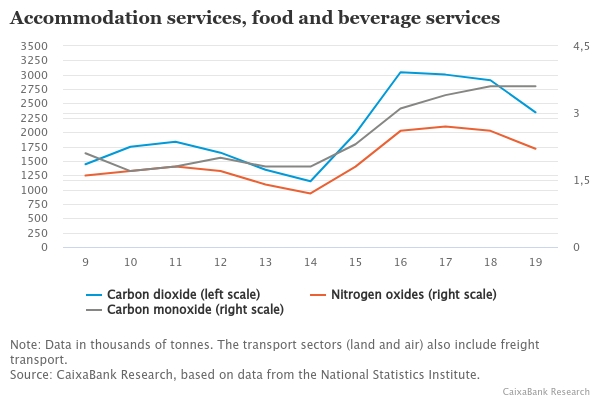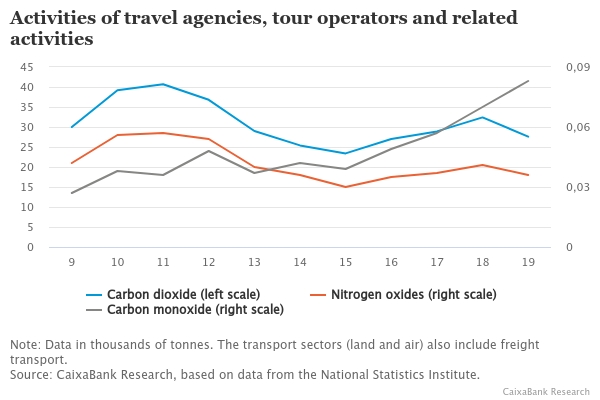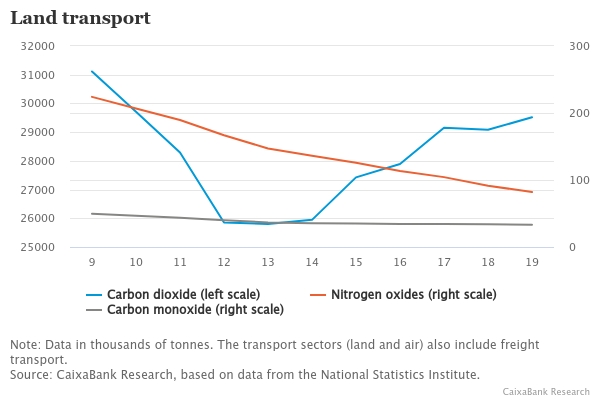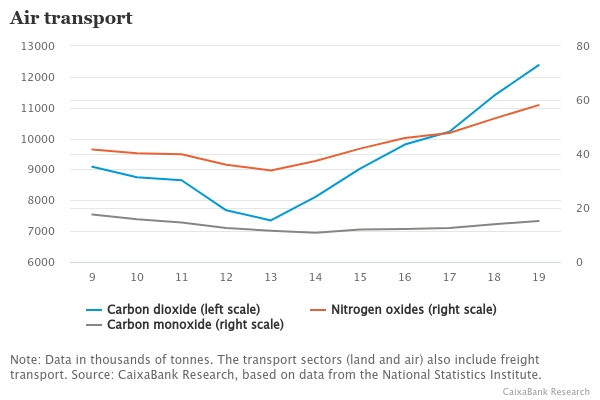CaixaBank Research (Pedro Álvarez Ondina) | Spain’s tourism industry has developed exceptionally in recent years, becoming one of the country’s main sources of business, income and employment. However, this strong development had also led to the emergence of some negative actions and social unease regarding the role played by tourism at certain destinations and moments until, in 2020, the coronavirus crisis paralysed the sector’s activity and highlighted its social and economic relevance for many areas in Spain. At present, the policies implemented by the European authorities and the Spanish government itself clearly indicate a way out of the crisis based on criteria of sustainability and resilience which, in the case of the tourism sector, consists of two aspects. On the one hand, tourism is particularly sensitive to the impact of climate change, such as rising sea levels, extreme weather events, environmental degradation and biodiversity loss. On the other hand, as tourism is an activity that involves high levels of atmospheric pollution and puts great pressure on natural resources, there is ample room for improvement to make the sector more sustainable.
In this respect, the World Tourism Organization (UNWTO) defines the principles of sustainability in terms of three areas: environmental, economic and socio-cultural. The first area aims to make optimal use of natural and environmental resources, as well as to preserve biological diversity. The economic aspect corresponds to tourism’s impact on the economy of the locality receiving tourists, in such a way as to promote long-term viable activities, with stable employment opportunities and well-distributed socio-economic benefits. Finally, the socio-cultural aspect seeks to conserve and strengthen the cultural and architectural assets and traditional values of the tourist destination in question. How can we measure the sector’s progress towards sustainability?
In order to gauge the degree of sustainability in the sector and the steps that should be taken in the future, we have created a relevant indicator for each of the three aspects defined by the UNWTO regarding tourism’s sustainability. It should be noted that our analysis has been carried out using data prior to 2020, as the effect of the pandemic on these indicators would distort the analysis contained in this article.
In environmental terms, we have taken the trend in greenhouse gas (GHG) emissions into the atmosphere by the sectors that make up Spain’s tourism industry. For this analysis, we have only taken into account the trend in the three gases that are most emitted into the atmosphere: carbon dioxide (CO2), nitrogen oxides (NOx) and carbon monoxide (CO). The first conclusion that can be drawn is that most of the GHG emissions come from the transport sector (accounting for around 12% of tourism GDP), specifically the emission of nitrogen oxides resulting from combustion engines. These sectors are among the most polluting of all industries. Moreover, the pollution level has increased since 2013 for air transport, and although they have decreased for land transport they are still at an incredibly high level. With respect to accommodation and hospitality services, as well as travel agency and tour operator activities, carbon monoxide is the pollutant emitted most into the atmosphere.7 Although the pollution level are not alarming, far from moderating they actually grew by 78% in the case of accommodation and 38% in the case of agencies and tour operators between 2013 and 2019.




The indicators of economic value consider the contribution made by tourism to the economic sustainability of each destination. The variables we have used to measure this are the average number of overnight stays per month (volume of activity) and the expenditure per tourist (value of that activity). The volume and value of tourism are essential to the economic sustainability of a destination: the greater the expenditure per day, the more efficient the destination in terms of generating tourism value.
The relationship between volume (number of overnight stays) and expenditure per tourist can be seen in the figure below. In the most tourism-oriented provinces (those with more than 10 million overnight stays per year), average expenditure is around 300 euros per tourist. The case of Las Palmas is particularly negative in this respect: it ranks second in terms of overnight stays but only has a modest average expenditure. Among the rest of the provinces, the average expenditure per tourist is below 175 euros. Girona, Alicante and Gipuzkoa are particularly positive in economic terms as they typically have a more modest volume of hotel stays but a very high expenditure per tourist.
To continue reading this report, click right here





